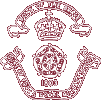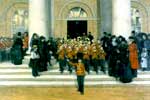


 |
 |
|
 |
||
| Navigation links at the bottom of this page | ||||||||||||||
| Dissecting Philip R. Morris | ||||||||||||||
Three versions of the Sons of the Brave painting by Philip R. Morris ARA are known to exist, but there might be more. One is on the premises of the property formerly occupied by the Royal Military Asylum, King's Road, Chelsea, a stone's throw from the Royal Pensioners Hospital. The other two are in the possession of the Duke of York's Royal Military School, Dover. One, a nine feet by six feet portrait painting hangs in the School's dining room. The other, a smaller, landscape version is hung in the school's administration building. The two versions, portrait and landscape, show distinct differences of composition. Close examination of the two suggests that the landscape painting is the earlier, inferior composition of the two, which leads one to speculate that Morris painted it as a writer might produce a draft text of a major work. The existence of the two paintings in the same place and the opportunity to inspect them at close quarters provides a fascinating insight into the mind of the artist. Anyone faced with a blank canvas, amateur or professional artist, is confronted with the question 'How am I going to fill this space?' From my own experience of carving sculptures from solid blocks of wood, I can understand the feeling of any artist who asks that question. Ideas fill the mind and, to a certain extent, can become all-consuming. Michael Angelo, who worked on the same block of marble into which three earlier sculptures had sunk their chisels, spent years sketching plans to finish his David masterpiece. Philip R. Morris was beset by the same problem in planning his major work, the nine feet by six feet portrait canvas of Sons of the Brave. Morris entered the Royal Academy School of Art in 1855 and had his work exhibited at age 21, the same year in which he was elected ARA. He was an accomplished but otherwise undistinguished artist able to make a reasonable living from his art. At the Academy, he was taught and mastered the skill of painting with a good eye for colour, depth and composition. This is shown in much of his work, which was for a long time technically competent, but prosaic and conventional. His skill with colour and perception is evident in his rural summer scenes, two examples of which are shown here. The best that could have been said of his work at this time was that it could have inspired or at least influenced the French impressionist school. Then he conceived the idea of painting Sons of the Brave, a magnificent achievement which firmly established his place and reputation among nineteenth century artists. |
||||||||||||||
|
||||||||||||||
In planning his masterwork, Morris must have made many visits to the Royal Military Asylum, Chelsea, to sketch the main building and the boys with their brass instruments and side drums, and to establish a palette. That is, artists select the colours with care and make notes on the selection for future use. A reddish range of shades to reddy yellow brick palette could be, for example, raw sienna, burnt sienna, crimson alizarin, French ultra marine, Payne's Grey, warm sepia and cadmium yellow. The artist would know or decide on what surface to paint, the size and type of canvas, its weave and the type gesso used to prepare it. Several 'flesh tone' exercises would be done. Morris would probably have made several portraits of the boy musicians and visitors who attended the school each Sunday morning. Despite a diligent search for his sketch material, nothing has been found. However, the smaller, landscape version exists and that is the remarkable record that gives clues as to how Morris developed his ideas for his masterful portrait. That is, the artist must have produced the landscape version first. This was his 'tester' with which to set the position and animation of the musicians and onlookers. It also resulted in his final choice of palette and selection of colours and tints. Look at the landscape canvas below. On this version, the smallest stroke of red will stand out like the proverbial sore thumb, which means that on a canvas dominated by scarlet, the one figure commanding the viewer's attention is the Chelsea pensioner on the right-hand side of the painting. This is tempered to some degree by the pensioner to the left of the left-hand column. Yet there is much for the observant eye to see. |
||||||||||||||
 |
||||||||||||||
| Landscape version of the Morris Sons of the Brave canvas in possession of the Duke of York's School | ||||||||||||||
Setting the shadows by the drum major in the centre, the sun is at half-past five. In contrast, the sailor-suited boy is without a shadow, while the pensioner at the rear by the window appears to be in sunlight. These minor details might have been obscured by a glaze added at the final stages of the work and before the final varnish was added. Another indicator of dash and haste is that several of the female figures in black are not finished to the standard of other images. Further, there are anomalies in the crowd scenes in the V formations that require explanation for the uninformed. The first V appears on the left, formed by the woman in black with a child, down to sailor boy and up to the girl holding the muff. The point of the second V is the drum major up to his left and right of the band. The third V is formed by the elderly woman with a umbrella up to the left of the right-hand column, then up past the pensioner. This array of Vs is like shark's teeth that give a subconscious message to the viewer, which is, 'Get out of the way. Keep clear. Don't enter the picture.' It is the prime goal of any artist to persuade the view to enter the picture, to become part of it. |
||||||||||||||
|
||||||||||||||
| The composition of the landscape version is one of moderation verging on the pedestrian. The scene is static and the mass of women in black dominates the painting. The front line of cornet players has advanced down the steps and the drum major stands poised on the gravel roadway. Note, too, not just that the colour and tint of the band uniforms clash with the pensioner, but the brickwork of the building and foreground are yellowish and autumnal.
Morris brings the portrait painting to life by inviting the viewer into the scene. Pigeons in flight, top and lower left, add movement, as does the girl with the hoop in the foreground being ushered by the young soldier from the path of the advancing band. There is no longer a clash of colour between the uniforms of the musicians and the pensioner. The girl at the left column has replaced the boy in the sailor suit, and the group of women in the foreground right, one holding a child, are in motion, moving out of the way of the band. Two trombone players replace cornet players at the left of the first rank. The high, robust columns help frame the canvas. There is more. The reds are muted, the pensioner is faded back and not so bright. A Union Jack appears in the background, a reminder, perhaps, of the English heritage on display. The band is marching forward, no doubt playing a well-known rousing march. The young soldier (with what seem over-sized gloves), moves the audience to a place of refuge, and the viewer feels a need to enter the painting and join the listeners, but with a perfect point of vantage. All that is happening is within one's sphere of vision. In his Sons of the Brave portrait, Morris produced a masterpiece that put all his previous work in the shade. His painting was remarkable for more than its technical excellence, for it was a pioneering work more than two years in the making. In 1878, the military band movement as we know it today was in its infancy and no canvasses of military bands then existed. Sons of the Brave was a first. Morris was without question the first artist to capture the essence of a large military band formation. That the one he chanced to portray in such excellent detail was of the orphaned children of soldiers in the uniform of their fathers was a bonus that helped capture the public imagination. The only nineteenth century painter whose work bears comparison with Morris's Sons of the Brave was Lady Elizabeth Butler (1846-1933), who specialized in painting military subjects. Interestingly, her only attempt to paint military musicians was a small work (about the size of the landscape version of Sons of the Brave) portraying the twelve surviving boy fifers and drummers of the 57th Foot (the Middlesex Regiment) during the Battle of Albuera in the Peninsular War in 1811. In any case, there is no doubt that Morris led the way in portraying a military band formation, which became a model for other artists to follow including, possibly, Lady Butler. Given the reasoning here set out, can anyone doubt that the landscape version of Sons of the Brave was the 'tester' for the larger canvas? I would conjecture that Morris presented the landscape version to the Duke of York's School following completion and exhibition of his portrait version. For the record, the Leeds Museums and Galleries (City Art Gallery), which own the Morris painting, loaned it to the school for hanging in 1927. |
||||||||||||||
| ||||||||||
|
© A. W. Cockerill 2011 Site Map Contact me | ||||||||||